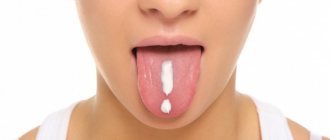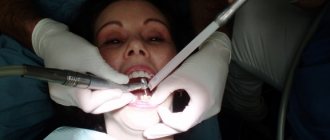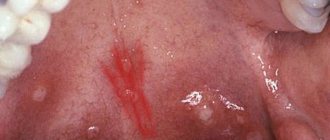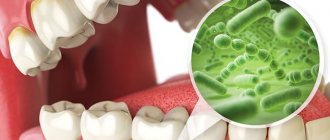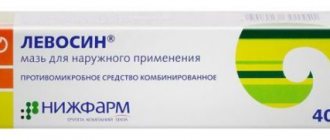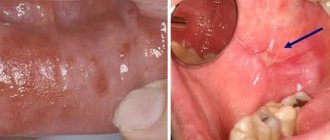Benign tumors of the oral cavity are neoplasms of various nature located in the mouth. Tumors of this localization do not tend to develop into malignant ones; as a rule, they have limited growth. The following neoplasms fall into this category:
- Papilloma;
- Myxoma;
- Cyst;
- Fibroma;
- Fibromatosis;
- Hemangiomas;
- Lymphangiomas.
The most common tumors are of epithelial origin, that is, they originate in glandular or squamous epithelium. In rare cases, tumors appear from muscle fibers or adipose tissue. A benign neoplasm can be localized on the tongue, on the inner surface of the cheeks, on the palate (hard and soft), in the area under the tongue, on the lips and on the gums.
The causes of benign tumors are currently not fully understood. Among the dominant risk factors are bad habits, various injuries, one-time (as, for example, during tooth extraction) or permanent (microtrauma caused by the edge of a broken tooth).
Mechanical injuries of the oral mucosa in children.
Depending on the duration of the injury, its intensity, and the reactivity of the body, hyperemia of the damaged area, swelling, desquamation of the epithelium, erosion or ulceration of the mucous membrane are detected. Traumatic lesions are often called decubital (from the Latin Decubitas - bedsore).
One of the causes of decubital erosions and ulcers in children in the first weeks or months of life is trauma to the teeth or one tooth that erupted before the birth of the child or in the first days and weeks after birth. Usually one or two central incisors erupt prematurely, mainly on the lower jaw.
The enamel and dentin of these teeth are underdeveloped, the cutting edge is thinned and during sucking the breast injures the frenulum and the lower surface of the tongue, which leads to disruption of the epithelial cover and inflammation in the mucous layer itself. This form of damage is classified as erosion. If, as a result of injury, the mucous layer itself is destroyed, then such damage is called an ulcer.
A similar lesion on the tongue frenulum can also occur in older children during whooping cough or chronic bronchitis, since prolonged coughing attacks are accompanied by protrusion of the tongue and the tongue frenulum is injured by the cutting edge of the front teeth (Rigi's disease).
Decubital erosions and ulcers of the cheek or lip can occur during the period of changing teeth, when the root of a baby tooth, which has not resolved for any reason, is pushed out by a permanent tooth, perforates the gum and, protruding above its surface, permanently injures the adjacent tissues.
In children from 1 to 2-3 years old, thin and flat foreign bodies (pumpkin and sunflower seed shells, apple core plates, fragments of toys, etc.) are often observed stuck to the hard palate.
Mechanical damage is common in children who have uneven, sharp or damaged teeth and a bad habit of biting, sucking the tongue, mucous membrane of the cheeks and lips between the teeth.
CLINICAL PICTURE OF MECHANICAL INJURIES OF THE ORAL MUCOSA IN CHILDREN.
In case of mechanical damage to the oral mucosa, the general condition of the child is not disturbed, sleep is calm, body temperature is normal. In case of defects in the upper layers of the epithelium resulting from habitual biting of the mucous membrane, eating is painless, children do not complain and do not consult a doctor. The doctor detects such lesions by examining the oral mucosa during routine sanitation. The mucous membrane is of normal color, but in those areas where it is injured by the teeth (in the cheeks, lips, along the edges of the tongue), its surface is uneven, fragments of white epithelium are visible, reminiscent of plaque from thrush, and sometimes there are small hemorrhages. Palpation of the mucous membrane in such children is usually painless. Foreign bodies stuck to the palate are covered with plaque, the mucous membrane around them is somewhat swollen and hyperemic.
Traumatic erosions have an irregular shape, are covered with a thin fibrinous coating, whitish-yellow in color, the surrounding mucous membrane is slightly or moderately hyperemic. Decubital ulcers come in different sizes and depths, have dense edges raised above the level of the surrounding mucosa, the bottom of the ulcer is covered with plaque, the surrounding mucosa is swollen and hyperemic. A young child becomes restless, sucks poorly at the breast or refuses it altogether. In children of preschool and school age, especially with bad habits, an eroded or ulcerated area of the mucous membrane is less painful, since prolonged irritation disrupts the function of the nerve receptors of the mucous membrane, and children often consult a doctor only when the process worsens due to secondary infection and the inflammatory reaction of the surrounding tissue accompanied by edema, lymphadenitis, etc.
When differentiating traumatic lesions and other chronic diseases of the oral mucosa, it should be remembered that decubital erosions and ulcers are observed only in areas accessible to biting; they never occur on the palate, arches, in the depths of transitional folds, or in the central areas of the back of the tongue. From the anamnesis it turns out that most children are practically healthy, some have psycho-emotional instability.
A peculiar lesion of the oral mucosa in children in the first months of life is the so-called Bednar aphthae, which more often occurs in weakened children who are bottle-fed, suffering from congenital heart defects, or who have suffered any diseases in the first months of life. Hypertrophy is the background against which minor tissue trauma by a long horn or while wiping a child’s mouth is sufficient to disrupt the epithelial cover. Erosions are most often located symmetrically at the border of the hard and soft palate, respectively, according to the projection onto the mucous membrane of the hook of the pterygoid process of the main bone. The defeat can also be one-sided. The shape of the erosions is round, less often oval, the boundaries are clear, the surrounding mucous membrane is slightly hyperemic, which indicates a state of hypergia. The surface of the erosions is covered with a loose fibrinous coating, sometimes clear, brighter in color than the surrounding mucous membrane of the palate. The size of erosions ranges from a few millimeters to extensive lesions that merge with each other and form a butterfly-shaped lesion. If a secondary infection occurs, erosions can turn into ulcers and even cause perforation of the palate.
Bednar's aphthae can also occur during breastfeeding if the mother's nipple is very rough, for example, after irradiation with quartz. Erosion in this case is located along the midline of the palate. The child becomes restless. Having started to actively suck, after a few seconds he stops sucking and crying, which is usually the reason for contacting a doctor.
TREATMENT OF MECHANICAL INJURIES OF THE ORAL MUCOSA IN CHILDREN.
For traumatic lesions of the mucous membrane, treatment is reduced to eliminating the cause that caused the injury. Prematurely erupted milk teeth should be removed, since their structure is defective, they quickly wear out and, in addition to trauma to the mucous membrane, can cause odontogenic infection. Foreign bodies from the mucous membrane of the palate are easily removed with a dental spatula.
In case of aphthae of newborns, it is necessary first of all to establish feeding of the child: natural through a pad for rough nipples of the mother or artificial through a short horn made of hard rubber, which does not stretch when sucking and does not reach the eroded surface.
To treat the oral cavity of children in the first months of life, weak antiseptics are used (0.5% solution of hydrogen peroxide, decoction of chamomile flowers, St. John's wort, tea, infusion of sage leaves). Vigorous wiping of the mouth and the use of cauterizing substances are unacceptable. It should be borne in mind that Bednar's aphthae heal very slowly, over several weeks or even months.
In older children, in case of injury, the sharp edges of the teeth are carefully ground off, the oral cavity is sanitized, and if indicated, drugs that suppress the cough center are prescribed (after consultation with a pediatrician). The role of bad habits is explained to the child and parents. If a conversation with children and parents does not produce results and the bad habit persists, the child should be referred for examination and treatment to a psychoneurologist. In some children, mainly with cicatricial deformities of the mucous membrane of the cheeks, when the mucous membrane is pinched between the upper and lower dentition, the manufacture of orthodontic appliances with vertical extensions that protect the mucous membrane is indicated.
For decubital ulcers, in addition to antiseptic treatment, it is advisable to prescribe applications of mixtures that stimulate healing (for example, vitamin A 500,000 units, vitamin B1 0.5 - 1 g, insulin 50 - 100 units, sea buckthorn, olive or sunflower oil up to 100 g). You can also use such official keratoplasty agents as vinylin, caroolin, rosehip oil, tesana emulsion, etc. Gauze napkins soaked in keratoplasty agent cover the corresponding group of teeth, isolating them from the affected mucous membrane. Small children can be allowed to suck on the indicated products on a small cotton swab stitched with a silk ligature.
Symptoms of Oral Cancer
The main symptoms of oral cancer include:
- the appearance of cracks, ulcers, wounds;
- inflammatory process;
- development of dental problems;
- pain;
- deterioration of general condition.
Patients complain of fatigue, weight loss, loss of work activity, and energy.
Take into account! Oral cancer develops rapidly, spreads, and forms metastases.
The patient may experience additional symptoms of oral cancer, for example, pain in the ear area, radiating to the temple or head. Against this background, neuropathological pain develops - tissue damage, the nerve cannot calm down for a long time. Psychological pain is a manifestation of the reaction of the cerebral cortex.
Thermal injuries of the oral mucosa in children.
They are rare in children, but are possible when eating hot food, especially milk and broth. The mucous membrane of the lips, the tip of the tongue, and the anterior part of the hard palate is mainly affected. It becomes swollen, hyperemic, and painful when touched. Less commonly, superficial intraepithelial vesicles form, which immediately burst. Upon examination in this case, fragments of white epithelium are visible on a hyperemic base. Prescribing antiseptics is unnecessary, since there is no deep defect in the epithelium, and therefore no conditions for secondary infection. For pain, painkillers are indicated: applications of a 0.5% solution of novocaine, lysozyme, 5–10% suspension of anesthesin in oil.
Treatment of oral neoplasia
Treatment of neoplasia is selected depending on the stage.
Radioactive therapy
Used in the early stages of oral cancer. This is an effective treatment with minimal impact on healthy tissue and no side effects. This includes brachytherapy - the effect of radioactive substances on the tumor itself.
Chemotherapy
It is used at all stages of oral cancer, helps reduce the tumor in size, and allows you to remove the remains of cancer cells after surgery.
Palliative care
It is used in severe stages of malignant tumors, when the patient has several months to live.
Surgical intervention
The goal is to completely remove cancer cells, otherwise they can spread to healthy areas. In case of a complex form, the patient may have part of the tongue and part of the bone of the facial part of the skull removed.
Chemical injuries to the oral mucosa in children.
These injuries are observed mainly in children 1–3 years old due to accidental ingestion of solutions of acids and alkalis used in everyday life. In this case, combined burns of the mucous membrane of the mouth, pharynx, and esophagus develop. The severity of the lesion is determined by the concentration of the drug and the duration of its effect. The mucous membrane becomes sharply hyperemic, then necrosis appears within a period of several hours to a day, the deepest usually on the lower lip. Necrotic tissues become saturated with fibrinous exudate; a thick film is formed, which is slowly torn off on the 7th - 8th day and at a later date. In an uncomplicated course, under such a film, tissue scarring and epithelization of the defect occur in parallel.
Chemical burns can be caused by many medications used in dental treatment: phenol, formalin, antiformin, acids, alcohol, ether, etc., so the dentist should be especially careful when using them, taking into account the easy vulnerability of the mucous membrane in children and the often violent reaction of the body in response to its damage.
TREATMENT OF CHEMICAL INJURIES OF THE ORAL MUCOSA IN CHILDREN.
For chemical burns in the first minutes and hours, it should be aimed at neutralizing the chemical agent with 1 - 2% solutions of sodium bicarbonate for acid burns and 1% hydrochloric acid solution or 3% citric acid solution for alkali burns. Further treatment consists of preventing secondary infection of the lesion and pain relief. For burns of the pharynx and esophagus, the child should be hospitalized in the ENT department.
Diagnosis of oral cancer in the oncology center
The first diagnosis is carried out by the patient himself; he can feel or feel the appearance of ulcers, pain and other symptoms in the mouth. Having independently established the presence of formations, it is recommended to immediately consult a doctor, he will completely examine the oral cavity.
Take into account! Early stage oral cancer is easier to treat. It is recommended not to skip a routine dental checkup. When neoplasms are detected, neoplasia must be classified. For this purpose, ultrasound examination, computed tomography, MRI, biopsy, and x-ray are prescribed. The doctor will listen carefully to the patient, because based on the complaints it is already possible to diagnose neoplasia.
